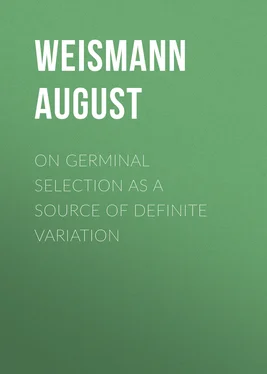August Weismann - On Germinal Selection as a Source of Definite Variation
Здесь есть возможность читать онлайн «August Weismann - On Germinal Selection as a Source of Definite Variation» — ознакомительный отрывок электронной книги совершенно бесплатно, а после прочтения отрывка купить полную версию. В некоторых случаях можно слушать аудио, скачать через торрент в формате fb2 и присутствует краткое содержание. Жанр: foreign_antique, Биология, foreign_edu, на английском языке. Описание произведения, (предисловие) а так же отзывы посетителей доступны на портале библиотеки ЛибКат.
- Название:On Germinal Selection as a Source of Definite Variation
- Автор:
- Жанр:
- Год:неизвестен
- ISBN:нет данных
- Рейтинг книги:4 / 5. Голосов: 1
-
Избранное:Добавить в избранное
- Отзывы:
-
Ваша оценка:
- 80
- 1
- 2
- 3
- 4
- 5
On Germinal Selection as a Source of Definite Variation: краткое содержание, описание и аннотация
Предлагаем к чтению аннотацию, описание, краткое содержание или предисловие (зависит от того, что написал сам автор книги «On Germinal Selection as a Source of Definite Variation»). Если вы не нашли необходимую информацию о книге — напишите в комментариях, мы постараемся отыскать её.
On Germinal Selection as a Source of Definite Variation — читать онлайн ознакомительный отрывок
Ниже представлен текст книги, разбитый по страницам. Система сохранения места последней прочитанной страницы, позволяет с удобством читать онлайн бесплатно книгу «On Germinal Selection as a Source of Definite Variation», без необходимости каждый раз заново искать на чём Вы остановились. Поставьте закладку, и сможете в любой момент перейти на страницу, на которой закончили чтение.
Интервал:
Закладка:
The meaning of formative laws here is that definite spots on the surfaces of the wings are linked together in such a manner by inner, invisible bonds, as to represent the same spots or streaks, so that we can predict from the appearance of a point at one spot the appearance of another similar point at another, and so on. It is an undoubted fact that such relations exist, that the markings frequently exhibit a certain symmetry, that—to use the words of the most recent observer on this subject, Bateson 8 8 Materials for the Study of Variation with Especial Regard to Discontinuity in the Origin of Species. London, 1895.
—a meristic representation of equivalent design-elements occurs. But I believe we should be very cautious in deducing laws from these facts, because all the rules traceable in the markings apply only to small groups of forms and are never comprehensive nor decisive for the entire class or even for the single sub-class of diurnal butterflies, in fact, often not so for a whole genus. All this points to special causes operative only within this group.
If internal laws controlled the marking on butterflies' wings, we should expect that some general rule could be established, requiring that the upper and under surfaces of the wings should be alike, or that they should be different, or that the fore wings should be colored the same as or differently from the hind wings, etc. But in reality all possible kinds of combinations occur simultaneously, and no rule holds throughout. Or, it might be supposed that bright colors should occur only on the upper surface or only on the under surface, or on the fore wings or only on the hind wings. But the fact is, they occur indiscriminately, now here, now there, and no one method of appearance is uniform throughout all the species. But the fitness of the various distributions of colors is apparent, and the moment we apply the principle of utility we know why in the diurnal butterflies the upper surface alone is usually variegated and the under surface protectively colored, or why in the nocturnal butterflies the fore wings have the appearance of bark, of old wood, or of a leaf, whilst the hind wings, which are covered while resting, alone are brilliantly colored. On this theory we also understand the exceptions to these rules. We comprehend why Danaids, Heliconids, Euploids, and Acracids, in fact all diurnal butterflies, offensive to the taste and smell, are mostly brightly marked and equally so on both surfaces, whilst all species not thus exempt from persecution have the protective coloring on the under surface and are frequently quite differently colored there from what they are on the upper.
In any event, the supposed formative laws are not obligatory. Dispensations from them can be issued and are issued whenever utility requires it . Indeed, so far may these transgressions of the law extend, that in the very midst of the diurnal butterflies is found a genus, the South American Ageronia, which, like the nocturnal butterfly, shows on the entire upper surface of both wings a pronounced bark-coloration, and concerning which we also know (and in this respect it is an isolated genus and differs from almost all other diurnal butterflies), that it spreads out its wings when at rest like the nocturnal butterfly, and does not close them above it as its relatives do. Therefore, entirely apart from cases of mimicry, which after all constitute the strongest proof, the facts here cited are alone sufficient to remove all doubt that not inner necessities or so-called formative laws have painted the surface of the butterflies' wings, but that the conditions of life have wielded the brush.
This becomes more apparent on considering the details. I have remarked that the usually striking colorations of exempt butterflies, as of the Heliconids, are the same on both the upper and the lower surfaces of the wings. Possibly the expression of a law might be seen in this fact, and it might be said, the coloration of the Heliconids runs through from the upper to the under surface. But among numerous imitators of the Heliconids is the genus Protogonius, which has the coloration of the Heliconids on its upper surface, but on its lower exhibits a magnificent leaf-design. During flight it appears to be a Heliconid and at rest a leaf. How is it possible that two such totally different types of coloration should be combined in a single species, if any sort of inner rigorous necessity existed, regulating the coloration of the two wing-surfaces? Now, although we are unable to prove that the Protogonius species would have perished unless they possessed this duplex coloration, yet it would be nothing less than intellectual blindness to deny that the butterflies in question are effectively protected, both at rest and during flight, that their colorations are adaptive . We do not know their primitive history, but we shall hardly go astray if we assume that the ancestors of the Protogonius species were forest-butterflies and already possessed an under surface resembling a leaf. By this device they were protected when at rest. Afterwards, when this protection was no longer sufficient, they acquired on their upper surface the coloration of the exempt species with which they most harmonised in abode, habits of life, and outward appearance.
At the same time it is explained why these butterflies did not acquire the coloration of the Heliconids on the under surface. The reason is, that in the attitude of repose they were already protected, and that in an admirable manner.
That exempt diurnal butterflies should be colored on the upper and under surfaces alike, and should never resemble in the attitude of repose their ordinary surroundings, is intelligible when we reflect that it is a much greater protection to be despised when discovered than to be well, or very well, but never absolutely, protected from discovery.
It has been so often reiterated that diurnal butterflies, as a rule, are protectively colored on the under surfaces, that one has some misgivings in stating the fact again. And yet the least of those who hold this to be a trivial commonplace know how strongly its implications militate against the inner motive and formative forces of the organism, which are ever and anon appealed to. No less than sixty-two genera are counted today in the family of diurnal butterflies known as the Nymphalidæ. Of these by far the largest majority are sympathetically colored underneath, that is, they show in the posture of rest the colorings of their usual environment. In a large number of the species belonging to this group the entire surface of the hind wings possesses such a sympathetic coloration, as does also the distant apex of the fore wings. Why? The reason is obvious. This part only of the fore wing is visible in the attitude of repose. Here, then,—as a zealous opponent of the theory of selection once exclaimed,—there is undoubted "correlation" between the coloring of the surface of the hind wing and of the apex of the fore wing. Correlation is unquestionably a fine word, but in the present instance it contributes nothing to the understanding of the problem, for there are near relatives and often species of the same genera in which this correlation is not restricted to the apex of the fore wings, but extends to a third or even more of their wings, and these species are also in the habit of drawing back their wings less completely in the state of rest, thus rendering a larger portion of them visible. There are species, too, like the forest-butterflies of South America just mentioned, the Protogonius, Anæa, Kallima species, etc., which have nearly the whole of the under surfaces of their fore wings marked according to the same pattern with their hind wings, and these butterflies when at rest hold their fore wings free and uncovered by their hind wings. Where are the formative laws in such cases?
Читать дальшеИнтервал:
Закладка:
Похожие книги на «On Germinal Selection as a Source of Definite Variation»
Представляем Вашему вниманию похожие книги на «On Germinal Selection as a Source of Definite Variation» списком для выбора. Мы отобрали схожую по названию и смыслу литературу в надежде предоставить читателям больше вариантов отыскать новые, интересные, ещё непрочитанные произведения.
Обсуждение, отзывы о книге «On Germinal Selection as a Source of Definite Variation» и просто собственные мнения читателей. Оставьте ваши комментарии, напишите, что Вы думаете о произведении, его смысле или главных героях. Укажите что конкретно понравилось, а что нет, и почему Вы так считаете.












